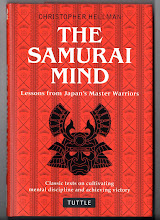
Domestic Strategy
Musashi's comparison of the way of strategy with the way of the carpenter is well known. He compares the way of the master carpenter (by which one should also understand builder) to the way of a military commander; the way he selects his men and assigns suitable jobs, the way he pays attention to details, for example, with the way a military commander approaches strategy. This approach is easy to understand, and similarly, I am occasionally struck by the applicability of everyday tasks to larger strategic questions.
Although we are not all familiar with the same things, this approach provides a good entry into strategic thinking. The key, however, is in identifying what elements are important to the success of the task, and what is extraneous.
With this in mind, I was struck recently by such reflections while cleaning the tape off a board I had used for stretching paper. Anyone who paints with watercolour or acrylic paint on paper will no doubt be familiar with stretching paper and, after the painting has been cut off the board, the necessary task of scraping off the left-over pieces of tape. Essentially, it's not much different from stripping off old wallpaper - something I have not done for many years now. Likewise, the intuitive approach, i.e. tearing off whatever loose strips you can before going to work with soaking and scraping, seems to be the most common and most successful.
As I like to do things my own way, I wondered if this intuitive approach was not, actually, counter-productive, and the whole lot could be taken off more efficiently in one go, rather than tearing off the upper layer and then working on what's left. The answer, I found, is no. The intuitive approach is actually more effective. It is better to go for whatever you can easily at first, and then go for the more stubborn bits later.
(I think anyone who does a lot of manual tasks, especially cleaning, could have saved me the trouble of trying this out., but I digress...)
The ease with which this works got me to pondering whether this approach might be more generally applicable - a useful rule of thumb for any situation. Certainly, it has a certain attraction as a catch all approach that can be adapted to a variety of situations - of course the question is, is it valid?
Like any rule of thumb, we are not concerned with universal validity, just general validity, but having said that, if it is indeed valid, why? What is it about this physical activity that gives it validity. Can this be extrapolated to other situations and activities?
I will explore this in my next post.









